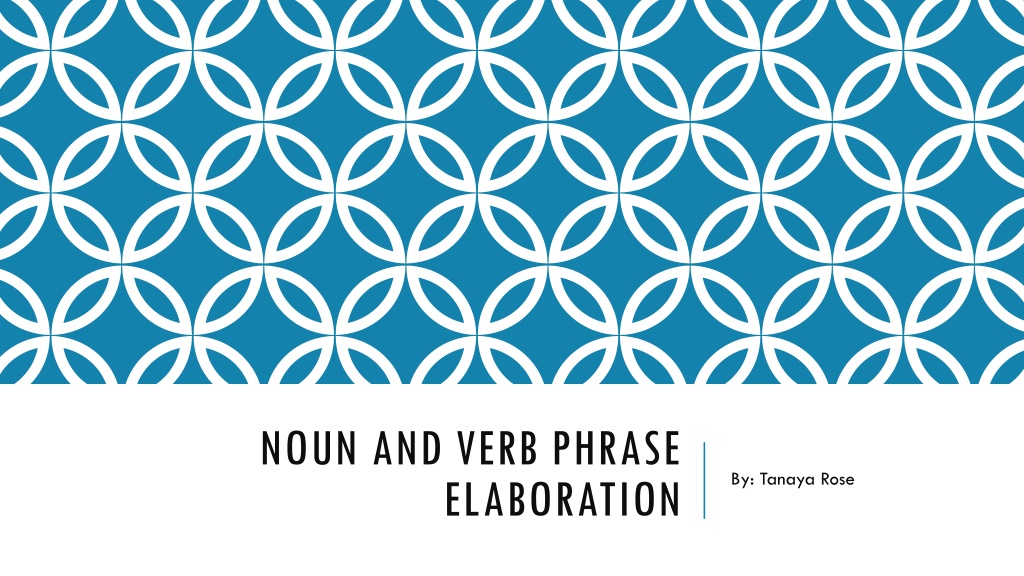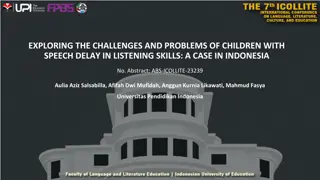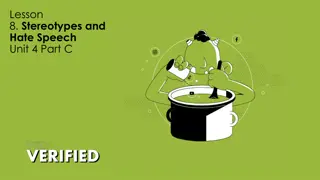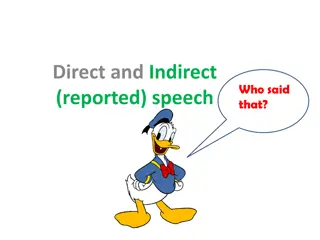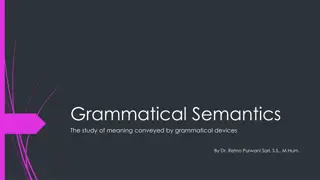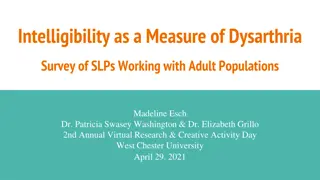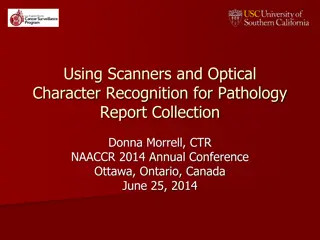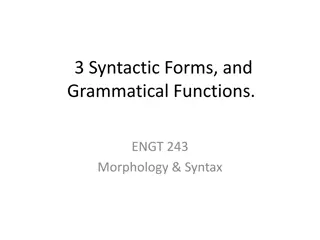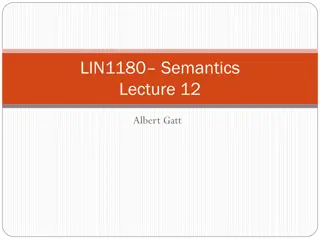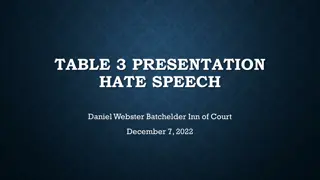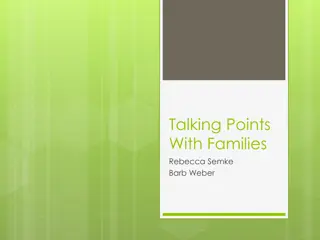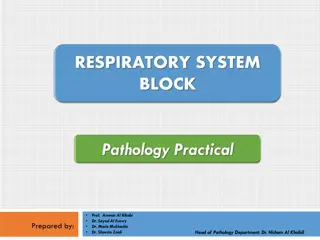Understanding Grammatical Development in Speech-Language Pathology
Explore a broader perspective of grammatical development in speech-language pathology focusing on noun and verb phrase elaboration. Learn about identifying and elaborating noun phrases, substitution tests, and the elements of an elaborated noun phrase. Gain insights into clinical approaches and language impairments related to grammatical development.
Download Presentation

Please find below an Image/Link to download the presentation.
The content on the website is provided AS IS for your information and personal use only. It may not be sold, licensed, or shared on other websites without obtaining consent from the author. Download presentation by click this link. If you encounter any issues during the download, it is possible that the publisher has removed the file from their server.
E N D
Presentation Transcript
NOUN AND VERB PHRASE ELABORATION By: Tanaya Rose
BROADER PERSPECTIVE OF GRAMMATICAL DEVELOPMENT In the field of speech language pathology, perspectives of grammatical development have focused on mean length of utterance (MLU) and grammatical morphemes, such as plural s and progressive ing (Owens, Pavelko, & Bambinelli, 2018). While MLU and grammatical morphemes have their clinical utility, it is important to take a broader approach to grammatical development by also focusing on the grammatical targets of noun phrase elaboration, verb phrase elaboration, and complex syntax. Children with language impairments (LI) produce (Eisenberg, 2013): Fewer two and three element noun phrases than their typically developing peers Less elaborate verb phrases Fewer complex sentences
OVERVIEW OF OBJECTIVES From this PowerPoint presentation you will learn: 1. How to identify elements of elaborated noun phrases (ENPs) and elaborated verb phrases (EVPs) 2. How to use sentence-combining techniques to facilitate noun phrase elaboration
IDENTIFYING A NOUN PHRASE: THE MAIN VERB How do you know what group of words form a noun phrase (NP) in a sentence? 1. Begin by locating the main verb in the sentence. Ask yourself: What is the action that the subject is doing (Writing Explained, n.d.)? What is the most important verb in the sentence? Example: The really tall giraffe at the zoo ate the green leaves off the tree.
IDENTIFYING A NOUN PHRASE: SUBSTITUTION TEST 2. Once you have located the main verb, ask yourself what words before/after the main verb can be substituted by a single pronoun. Examples: The really tall giraffe at the zoo ate the green leaves off the tree. He ate them. The silly frog hopped over the fence. He hopped over it. Playing soccer all day made the boy tired. It made him tired. The toy car was going really fast. It was going really fast. If the string of words can be substituted by a single pronoun, you have evidence that those words form a noun phrase!
ELABORATED NOUN PHRASE (ENP) ELEMENTS The most basic noun phrase consists of only a single word/noun. Example: Bears like honey. Children can expand on a single noun by using the following elements: Articles Possessive pronouns Adjectives Descriptors Quantifiers Demonstratives Numerical Terms
ENP ELEMENTS: ARTICLES What is an article? A function word that determines if the speaker is referring to a specific or unspecific noun (Grammarly, n.d.). 1. The definite article the Used when the speaker is referring to a specific noun Example: Pass me the cup. Meaning: there is a specific cup that the individual wants passed to them. 2. The indefinite article a/an Used when the speaker is referring to an unspecific noun Example Pass me a cup. Meaning: the individual is not requesting a specific cup. ENP: Article + Noun
ENP ELEMENTS: POSSESSIVE PRONOUNS What are possessive pronouns? Pronouns that convey ownership They do NOT contain an apostrophe 1. Independent possessive pronouns Can stand alone: replace a noun in a sentence Independent Possessive Pronouns mine ours yours yours (pl) his theirs hers its Example: The book on the desk is Sally s. The book on the desk is hers.
ENP ELEMENTS: POSSESSIVE PRONOUNS CONTINUED 2. Dependent possessive pronouns (aka possessive adjectives) Can NOT stand alone: occur before a noun Dependent Possessive Pronouns my our your your (pl) his their her its His train set. vs The train set was his. Dependent vs independent ENP Example: Possessive Pronoun + Noun *** Owens et al. (2018) also count independent possessive pronouns as an element of an ENP.
ENP ELEMENTS: ADJECTIVES What is an adjective? A word that modifies or describes a noun. It must occur in a noun phrase to be considered an element of an ENP. 1. Possessive noun Noun that conveys ownership Contains an apostrophe Example: Dad snew car. Incorrect example: The new car is Dad s, as Dad sis not modifying a noun in a NP. 2. Ordinal Conveys position in a series (e.g., first, second, last, next) Occurs before a noun Example. He won first place in the race. Incorrect example: He will always come first, as first is not modifying a noun; thus, is not an ENP.
ENP ELEMENTS: ADJECTIVES CONTINUED 3. Adverb An adverb is considered an adjective when it modifies an adjective (e.g., really, very) Example: She was a very happy girl. Incorrect example: The girl was very happy, as very happy is an adjective phrase, not a noun phrase. 4. Adjective Occurs before a noun Describes a quality of the noun Example: The funny puppy rolled over. Incorrect example: The puppy was funny, as funny is in its own adjective phrase, not a noun phrase. ENP Example: Article + Adjective + Noun
ENP ELEMENTS: DESCRIPTOR What is a descriptor? An open compound noun noun + noun The first noun modifies the second noun. There is a space between the two nouns. A descriptor is considered a type of adjective by Owens et al. (2018), but is counted separately from adjectives when scoring the language sample. Examples: Fish tank Bus stop Apple tree NP NP NI NI ENP Example: Article + Descriptor Noun 1 Noun 2
ENP ELEMENTS: QUANTIFIER What is a quantifier? A function word that specifies an amount. Quantifiers some a lot any a few much several many enough Example: I would like some cake. ENP Examples: Quantifier + Article + Noun Quantifier + Possessive Pronoun + Noun I would like some of the cake. All of my friends are nice.
ENP ELEMENTS: DEMONSTRATIVE What is a demonstrative? A function word that indicates the identity of the thing being referred to by the subsequent noun. Demonstrative this that these those Example: Look at that bird. ENP Example: Quantifier + Demonstrative + Noun have gone bad. Some of those apples
ENP ELEMENTS: NUMERICAL TERM What is a numerical term? A function word that conveys an actual or specific number (e.g., one, two, three ). Example: Goldilocks and the three little pigs. ENP Example: Quantifier + Numerical + Noun spots. All four dogs had black
ENP ELEMENTS: TRICKIER CASES Embedded clauses A clause that is inserted into the main clause. It contains its own subject and verb; thus, it contains its own NP(s). Example One: The waitress who served us our food was friendly. NP in the main clause: the waitress NP in the embedded clause: our food Example Two: The soup, that s in the pot, is very hot. NP in the main clause: the soup NP in the embedded clause: the pot
ELABORATED VERB PHRASE (EVP) ELEMENTS Like NPs, as children develop, they also produce more elaborate verb phrases (VPs). Elements of EVPs include: BE copula Irregular past Infinitive phrases Prepositional phrases BE Auxiliary Do/does + verb Modal Auxiliaries NOTE about gerunds: a gerund functions as a noun even though it looks like a verb. Examples: Talking in the library is not allowed. She loves singing. Singing could be replaced by an object and the sentence would still make sense.
EVP ELEMENTS: BE COPULA When the verb be is used as the main verb in the sentence, it is called a copula. Example: The kitten was sleepy. Be Copula is am are was were
EVP ELEMENTS: IRREGULAR PAST Some verbs are not inflected with the regular past tense marker ed. Instead, they change forms when in the simple past tense. Examples: Choose chose Eat ate Hear heard Freeze froze Speak spoke
EVP ELEMENTS: INFINITIVE PHRASES Infinitives have the structure to + simple form of the verb. The simple form of the verb has no inflection or tense marking: it is the root/stem form. When infinitive phrases occur after a verb, they are technically gerunds, as they can be replaced with a noun and the sentence would still make sense. An infinitive phrase is considered an element of an EVP regardless of if it is a gerund. Examples: She loves to read. I like to bake chocolate chip cookies.
EVP ELEMENTS: PREPOSITIONAL PHRASES (PP) Prepositional phrases contain a preposition and a NP (P + NP). Prepositional phrases are complements of the verb. Examples: The fireman went up the ladder. I keep my bicycle in the garage. PP NP PI Preposition Noun Phrase
EVP ELEMENTS: BE AUXILIARY The verb be functions as an auxiliary when it supports the main verb. It helps supply tense information. Examples: She was walking on the sidewalk. He ssinging in the school concert. Incorrect example: One of my favourite things is painting. Is functions as a copula here, as painting is a gerund. Tense Phrase Be Auxiliary VP TI is were am been are being BE Auxiliary Verb Phrase was
EVP ELEMENTS: DO/DOES + VERB The verb do can also function as an auxiliary or helping verb. Examples: She does look nice in her yellow dress. He doesn teat brussels sprouts. ___ + verb do does don t doesn t
EVP ELEMENTS: MODAL AUXILARIES Modal auxiliaries express (Grammarly, n.d.): Possibility Permission Ability Obligation Modal Auxiliaries can used to could ought to may shall might should must will need would
INTERVENTION IDEA FOR NOUN PHRASE ELABORATION: SENTENCE-COMBINING Sentence combining is a writing intervention that involves systematic instruction and structured practice (Saddler & Asaro-Saddler, 2010). While technically a writing intervention, its strategies can be applied to oral language intervention. The child practices combining two or more short sentences into a more complex sentence. If a clinician was targeting articles and adjectives, as well as expanding ENPs to three elements, they could get the child to practice combining sentences such as: Base clause: The bird sat in the nest. Sentence to be combined: The bird is red. Combined: The red bird sat in the nest. Result: The child produced a three-element ENP that has both an article and an adjective: the red bird.
SENTENCE-COMBINING: PRACTICE After tallying the results of a 50-utterance language sample, you decide to work on thee element NPs that contain a possessive pronoun and an adjective. What sentence could be combined with the following base sentence to get the desired result? Base Sentence: My bicycle is in the shed. Sentence to be combined:
SENTENCE-COMBINING: PRACTICE CONTINUED Example sentences to be combined: My bicycle is purple. My bicycle is new. Once the child is successful with combining two sentences, you could work on combining more than two sentences to get NPs with multiple adjectives, such as: My new purple bicycle is in the shed.
REFERENCES Eisenberg, S. L. (2013). Grammar intervention: Content and procedures for facilitating children's language development, Topics in Language Disorders, 33(2), 165-178. doi:10.1097/TLD.0b013e31828ef28e Grammarly. (n.d.). Articles. Retrieved from https://www.grammarly.com/blog/articles/ Grammarly. (n.d.). Modal verbs: Definition and usage. Retrieved from https://www.grammarly .com/blog/modal-verbs/ Owens, R. E., Pavelko, S. L., Bambinelli, D. (2018). Moving beyond mean length of utterance: Analyzing language samples to identify intervention targets. Perspectives of the ASHA Special Interest Groups, 3(SIG 1), 5-22. doi:10.1044/persp3.SIG1.5 Saddler, B., & Asaro-Saddler, K. (2010). Writing better sentences: Sentence-combining instruction in the classroom, Preventing School Failure, 54(3), 159-163. doi:10.1080/10459880 903495851 Writing Explained. (n.d.). What is a main verb? Definitions, examples of main verbs. Retrieved from https://writingexplained.org/grammar-dictionary/main-verb
